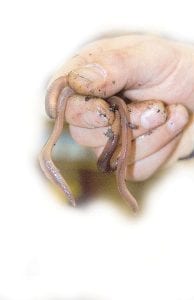The hunt is on for invading earthworms in North Shore parks and wayside rests. In late August, scientists searched the forest floor for visual indicators that non-native earthworms might be having an effect on this ecosystem.
In September and October, people interested in the project are invited to help collect and identify earthworms. Go to the web site at www. GreatLakesWormWatch.org for more information and to sign up.
Many people are still surprised to learn that these ribbed wigglers, coveted by anglers and gardeners, are not native to this region. Earthworms were introduced by Europeans some 2 5 0 years ago with plants and in ship ballast from across the ocean. Subsequent generations of Americans have moved them throughout the country, especially around lakeshores when leftover bait is turned loose.
What does this mean for the forests in this region? According to NRRI scientist Cindy Hale, it can mean stress on the forest floor. Beloved trilliums, orchids and other spring and summer flowering plants are threatened, perhaps even the regeneration of sugar maple trees.
The scientists are searching the following parks: Jay Cooke, Gooseberry, Split Rock, Tettegouche, Temperance, Crosby Manitou, Judge Magney, and Grand Portage, and the Caribou and Kadunce way side rests on Highway 61.
“For thousands of years, no earthworms existed in this region until European settlers began arriving around the mid- 1800s,” said Hale. “But they continue to be transported, intentionally and unintentionally, through a range of human activities, from dumping bait to transporting compost and mulch.”
There are several species of earthworms that are not yet widespread across the Great Lakes region, but have the potential to be very destructive. Since earthworms on their own travel very slowly, people need to be aware and help prevent spreading them unintentionally. There are about 16 earthworm species that are invading North America (of 3,000 to 4,000 species globally) and research shows that the more species of earthworms found in a site, the greater the potential impacts.
“Many people have learned since kindergarten that earthworms are good because they mix and aerate the soil,” said Hale. “But researchers are documenting dramatic changes to the native understory plant species and tree seedlings because earthworms change the soil structure and nutrient availability for these plants.”
This summer’s research has focused on identifying the level of impact by exotic earthworms throughout the north shore region so land managers can protect forested areas not yet invaded.
Citizen volunteers will learn how to catch and identify earthworms, and how earthworm invasions can lead to a cascade of changes in hardwood forest ecosystems that can negatively affect many forest plants and animals.



Loading Comments